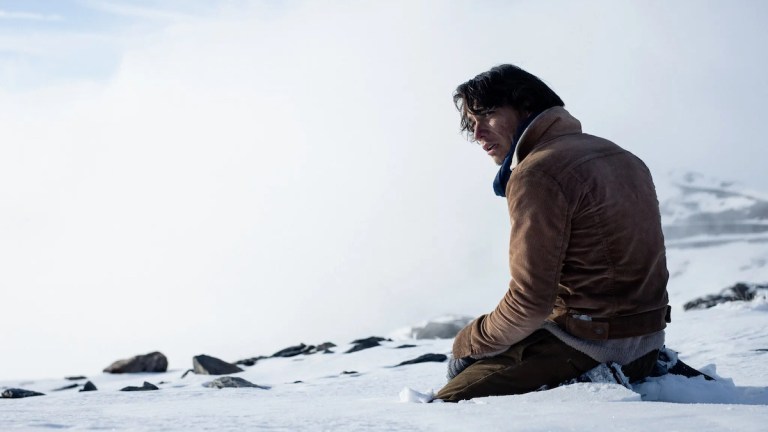Society of the Snow’s Ghostly Narration Changes the Meaning of the True Story
More than previous adaptations, Society of the Snow is as much about those who didn’t come back from the “Miracle in the Andes” as it is about the survivors who did….

This article contains major Society of the Snow spoilers.
It’s the twist that makes or breaks Society of the Snow for viewers. Like the famous Hollywood version of this true story of survival in the face of unimaginable catastrophe, Society of the Snow is narrated by a fictionalized version of one of the young men who endured it. The real-life Numa Turcatti boarded Uruguayan Air Force Flight 571 on Oct. 13, 1972; he would survive a nightmarish plane crash that left him and members of the Old Christians Rugby Club stranded at the top of the world; and he would face the unimaginable choice of eating from the human dead.
Yet as J.A. Bayona’s Society of the Snow goes along, a slowly spiritual bent unfurls. We are first clued into this by Numa (who is played by Enzo Vogrincic in the film) musing over the existential and philosophical implications of their plight. Lost and seemingly forgotten by the outside world, those who walked away from the crash faced almost certain death in a landscape where, as Numa’s voiceover considers, “The only thing that doesn’t belong is us.” Eventually, Numa even makes a confession to the audience: He is not coming down from this mountain. In fact, he would be the last person on a plane that carried 45 souls aboard to perish. A final light extinguished—but one that would allow the remaining 18 survivors to keep their own flames flickering.
Indeed, Numa’s final real-life note to his companions—his last will and testament—is “there is no greater love than to give one’s life for friends.” He bequeaths his body as nourishment for the other survivors who will carry on for him.
This is a striking departure from how Hollywood framed the story in 1993’s Alive, a movie largely told from the point-of-view of Carlitos Páez (Bruce Ramsay), one of the teenagers who was rescued, as well as Nando Parrado, who along with Roberto Canessa walked more than 38 miles in mountainous terrain and snow in order to find help. It also works against audience expectation when it comes to films about true stories. Generally, we are encouraged to believe we are watching a literal reenactment of what occurred, and how it was remembered by those who lived through it.
How can we truly know Numa Turcatti’s memories though? Or even fully understand how he really felt about having his picture taken when he was never able to share those thoughts. That is the knotty central dilemma at the heart of Society of the Snow, and what Bayona wants the audience to wrestle with.
While for viewers of a certain age, 1993’s Alive is a classic (or at least nostalgic) touchstone, there is no denying it flattens a grueling story of survival, suffering, and spiritual searching into an adventure yarn. The film doesn’t even bother to consider what life was like for the survivors of the Old Christians Rugby Club either before the crash or after it. Rather Alive begins moments before the crash and ends with the survivors’ undeniable euphoria as they are rescued.
Society of the Snow expands on both sides of the event: showing Numa’s life ahead of the crash, and what it is like to be a national hero when you’re a starved young man surrounded by cheering crowds of strangers. But Numa is notably not such a man at the end.
After being as close to a moral pillar as anyone could have in such extreme situations—with Numa remaining the most vocally against resorting to cannibalism, even as his own body wasted away from malnourishment—the 25-year-old law student died. In the film, his last words include him saying: “I want you to know you have my permission to use my body…. I know I’m not making it out. But it’s okay. I’m at peace with it.”
By making this the center of Society of the Snow, Bayona expands the canvas of his film to include what its very title suggests: the full society of young people who lived and died during those 72 harrowing days. It’s not just a tale of survival. It’s a tale of a shared sacrifice that has become something spiritual or holy in the minds of many, including the survivors. For example, Alfredo Delgado (or Pancho as his friends called him and as played by Valentino Alonso in the film) became a motivational speaker and has been candid more than once about the “communion” he and others felt from eating the dead.
On one such occasion, Delgado said, “Then the moment came when we had nothing to eat and we thought that if Jesus at His last supper had shared His flesh and blood with His Apostles, then it was a sign to us that we should do the same. We took this, the flesh and blood, and that was an intimate communion between us all. It was this that helped us to survive.”
In Delgado’s mind, those who died on the mountain were the best of them, and God took them after they had taught the others about courage and sacrificing for others. Those lessons literally lived on in those who consumed the bodies. So while the movie’s Numa is depicted as spiritually vexed and anguished by his ordeal, his narration and final letter to his friends is an ultimate affirmation to live—with him giving his last full measure for their survival. Society of the Snow is thus designed to open itself up to that interpretation for the viewers—as well as to put more focus on the experience of those who didn’t make it out.
When discussing the new film with The Hollywood Reporter in September, Bayona noted that (unlike Alive) he was able to get permission from all the survivors and all the families of the deceased to use the real names in the film, and to attempt to tell their story while wrestling with the bigger questions about what truly makes you want to live, and for whom would you die.
“The fact that I was putting the point of view from the other side made them very interested,” Bayona said of some family members of the deceased. “I think somehow it’s the first time we’re telling the story of the whole society and that was very important, not just the survivors, but their families.”
This is echoed by the real-life survivor Roberto Canessa who has told the press he was pleased with the film’s wider scope.
“I believe that justice was done,” Canessa said to Remezcla. “The world was dazzled by those who had survived, but many of us survived thanks to the work of others.” Canessa eventually added that it was “very good for the families of those who did not return to know that yes, they died, but it was not in vain.”
By allowing the man most opposed to the act of cannibalism, but the last one to most openly offer his body to the others, be our narrator, Society of the Snow forces viewers to confront not just what you might do in order to survive, but what you would accept in that situation. You get maybe a hint of that intimate communion these people felt at the end of the world.
